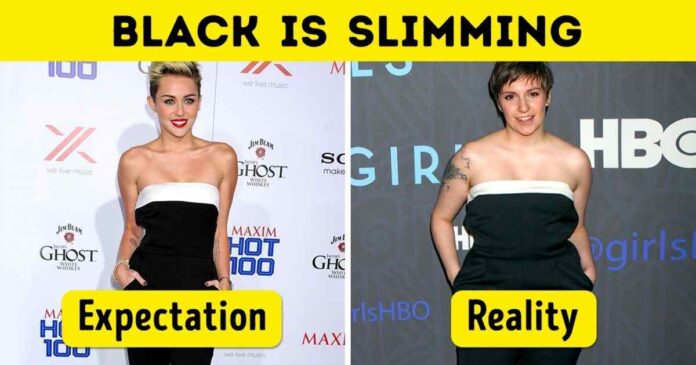
Modern fashion’s key criteria for its followers is to break the rules in order to showcase individuality. However, few people dare to deviate from the idea of a style that has become ingrained in their minds.
Contrary to popular belief, black is not slimming.

In truth, black isn’t for everyone, and it can’t cover extra weight on its own. You need a well-chosen cut, not black garments, to make your body appear slimmer.
Women who want to cover their imperfections should avoid wearing shiny black fabric or fur, according to stylists. Contrasting accents, on the other hand, will help to produce a magnificent image and divert attention away from flaws.
Myth: horizontal stripes make the body appear larger.

In fact, clothing style, as well as the colour and breadth of stripes, are important. The body is given more volume by large contrast lines. It is visually lengthened by narrow horizontal stripes.
Stylists advise: Feel free to utilise narrow stripes as long as you keep your body type in mind. Striped apparel should be paired with items that help to create more vertical lines.
Myth: light clothing makes you look obese.

In reality, the style takes precedence over the hue.
Choose a cut that is appropriate for your body and emphasises its benefits, according to stylists. To create images for various occasions, mix light clothing with things of other hues.
Misconception: only tall ladies look attractive in short pants.

In truth, shortened pants aren’t just for people with long legs; they look pleasant and flirtatious on everyone.
Ankle leggings in bright hues, according to stylists, can visually shorten the body. Short women should choose models with high waists in calm colours and wear them with heels.
Contrary to popular belief, large clothing suits everyone.

In truth, most girls seem more lovely in voluminous clothing, but there are those who should be cautious when selecting such attire.
Oversized garments are ideal for tall and skinny women since they add vulnerability to the appearance. Short females, as well as those with non-standard bodies, should keep proportions in check and avoid wearing more than one voluminous garment.
Contrary to popular belief, a wide belt “creates” a waist, making the body appear thinner.

In fact, a wide or flashy belt, which is meant to bring emphasis to the waist, has the opposite effect on women who are overweight: it draws attention to problem regions.
Curvy ladies should choose for knee-length or somewhat longer dresses with a waistband that can be pushed up or down, according to stylists. V-neck dresses serve to visually lengthen the neck and highlight the breast.
Misconception: combining more than three colours in a look is bad taste.

In truth, the “no more than three colours” rule was created for individuals who adhere to a dress code and don’t want to stand out. You can safely blend more than three colours in one image if you have a sense of style and harmony.
Choose clothing in which a specific colour will stand out, according to stylists. The remaining shades should complement the base colour rather than compete with it. Keep in mind the color-combination guidelines.
Myth: You can’t merge many prints in a single image.

In truth, multiple patterns in one image appear fresh and nontrivial, but they must accentuate the image’s appearance and complement it rather than divert attention away from it.
Patterns should have something in common, such as colour, according to stylists. The same pattern in many sizes would be ideal. Geometric figures (squares, rhombuses, polka dots, stripes) complement each other and other patterns.
A common misconception is that pink is exclusively appropriate for children and young girls.

In reality, it can be worn at any age depending on the style and hue.
Combining pink with other colours (white, grey, beige, blue, purple) is recommended by stylists, taking into account your skin tone and body shape. Coral colours are recommended for women in their fifties.
Frills and flounces are said to make you look obese.

Flounces and frills, in reality, give your image softness. Excessive ornamental features, on the other hand, visually add a few of pounds.
Frills on the sleeves are the safest option, according to stylists. They are suitable for anyone and have a stunning appearance. If you don’t have a model body, stay away from dresses with merely frills. They make the body “wider.”
Preview photo credit East News
